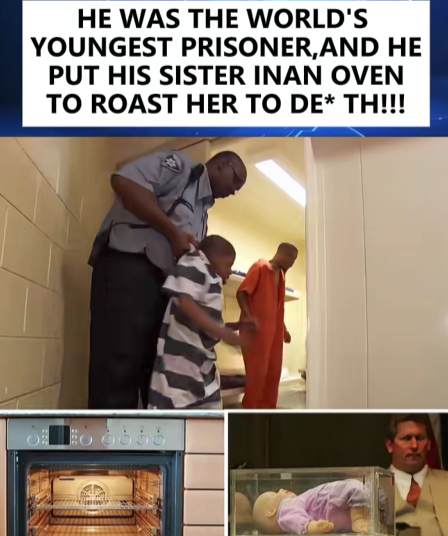In one of the most disturbing and heartbreaking cases in modern history, a young child became the world’s youngest prisoner after committing an act so horrifying that it left investigators and psychologists stunned for decades.
The story begins in the late 1960s, when a tragedy unfolded inside a small family home in the United States. A five-year-old boy, barely old enough to understand right from wrong, was accused of taking the life of his younger sister in an unthinkable way. According to reports from the time, the child allegedly placed his sister in an oven and turned it on — an act that would haunt everyone involved for the rest of their lives.
Police officers who arrived at the scene described it as one of the most shocking sights they had ever encountered. The boy, confused and frightened, reportedly told authorities that he was “playing” and didn’t understand what he had done. Yet the consequences were irreversible — and the event quickly drew global attention, sparking fierce debates about child psychology, criminal responsibility, and justice.
Due to his age, the boy couldn’t be treated as a traditional criminal. Courts, social workers, and psychologists spent months deciding how to handle such a rare and tragic case. Ultimately, he was placed in a juvenile facility under heavy supervision, making him the youngest individual ever incarcerated for a violent act.
Experts have long debated whether he truly understood the gravity of his actions. Many believe the tragedy was the result of neglect, lack of supervision, and exposure to violence at home. Psychologists at the time argued that no child that young could form malicious intent — rather, they acted out of imitation or confusion. “This wasn’t a case of evil,” one child behavior expert said. “It was a failure of protection, a breakdown of everything that should keep children safe.”
The case led to significant reforms in how the justice system treats minors accused of violent crimes. It also forced society to confront uncomfortable questions: How do you hold a child accountable for something so dark? And where does punishment end and rehabilitation begin?
As the years passed, the boy grew up away from the public eye. His identity was sealed, and details of his later life remain largely unknown. Some reports suggest he underwent years of therapy and eventually lived a quiet, anonymous life as an adult. But the legacy of his childhood actions still lingers — a haunting reminder of how fragile the line between innocence and tragedy can be.
Even decades later, the case remains a grim chapter in criminal history — one that challenges our understanding of morality, responsibility, and the deep psychological scars that can form even in the youngest minds.
It’s not just a story about crime — it’s a story about a world that failed two children long before the tragedy ever happened.
